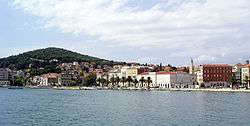Marjane, Marjane
"Marjane, Marjane" (lit. "Marjan, Marjan") is a Croatian song from Dalmatia. The name refers to the Marjan hill which overlooks the largest city of Dalmatia, Split, and on which the main (large) city flag is raised. It originates from a folk song sung in the city during the late 1930s, which was first recorded by the poet Ivo Tijardović.[1] Its melody was also used for the Slovenian patriotic song Janez, kranjski Janez (John, John of Carniola).


During World War II the song (with somewhat expanded wording) became very popular among the Yugoslav Partisans. The original song was played on the radio of the Nazi-puppet Independent State of Croatia, the Croatian Radio (Hrvatski krugoval).[2] The original lyrics serve as the official festive song of the city of Split. The song, being traditional, does not have a strictly defined ending, so its ending has changed through time and ideologies. Numerous artists have recorded the song. Najbolji Hrvatski Tamburaši included it in their 1989 release Hrvatska pjesmarica.[3] Trio Gušt released a version with new lyrics in 2009.[4]
Original (core) lyrics
| Croatian | English translation |
|---|---|
|
Marjane, Marjane, Marjane, Marjane, Milu trobojnicu, milu trobojnicu, |
Marjan, Marjan, Marjan, Marjan, The dear tricolour, the dear tricolour, |
Historical full versions

Partisan version
| Croatian | English translation |
|---|---|
|
Marjane, Marjane, Marjane, Marjane, Na kojon se čita, na kojoj se čita A na vrh barjaka, a na vrh barjaka Tko se pod njim bije, tko se pod njim bije, I još jedno slovo, i još jedno slovo, Živila sloboda, živila sloboda, |
Marjan, Marjan, Marjan, Marjan, On which is read, on which is read, And on top of the flag, and on top of the flag, Those who fight beneath it, those who fight beneath it, And another word, and another word, Long live the freedom, long live the freedom, |
In later versions, from the beginning of the Informbiro period until the Tito–Stalin split in 1948, the stanza with the reference to Stalin was no longer popular and became used less and less. It was revived in the 1970s nationalist version, with "Jesus" replacing "Stalin" in the wording. The first two stanzas of this version are featured in the Academy Award-nominated motion picture The Battle of Neretva.[5]
Contemporary version
| Croatian | English translation |
|---|---|
|
Marjane, Marjane, Marjane, Marjane, Milu trobojnicu, milu trobojnicu, Pod kojim su pali, pod kojim su pali, Tko se pod njim bije, tko se pod njim bije, I još jedno slovo, i još jedno slovo, Živila sloboda, živila sloboda, |
Marjan, Marjan, Marjan, Marjan, The dear tricolour, the dear tricolour, Under which they fell, under which they fell, Those who fight beneath it, those who fight beneath it, And another word, and another word, Long live the freedom, long live the freedom, |
This is the version more widely known in post-1989 Croatia.[6] One of its first large scale performances was on May 30, 1990 by the Croatian singer Duško Lokin.[7] It is often sung by Torcida, the supporters of the Split football club, HNK Hajduk.[8]
See also
- Marjan
- Split
- Dalmatia
- Ivo Tijardović
- Croatia
- Music of Croatia
- Flags of Croatia
- History of Croatia
References
- Ivan Ugrin (2002-07-16). "Naš je barjak hrvatski!". Slobodna Dalmacija (in Croatian). Retrieved 2012-10-15.
- Jonjić, Tomislav (December 2008). "Jadranske teme u Hrvatskom narodu od travnja 1941. do rujna 1943". Journal of Contemporary History. Zagreb, Croatia: Croatian Institute of History. 40 (3): 911–932. ISSN 0590-9597. Retrieved 2012-10-16.
- "Hrvatska pjesmarica - 1989 - Najbolji Hrvatski Tamburaši (Zlatni Dukati)". Diskografija.com. 2006-12-01. Retrieved 2012-10-15.
- Trio Gušt oživio Marjane, Marjane... Archived 2012-03-02 at the Wayback Machine
- "Yul Brynner & Marjane, Marjane - Battle of the river Neretva". YouTube. 2007-06-24. Retrieved 2012-10-15.
- Marjane, Marjane Archived June 6, 2007, at the Wayback Machine
- "DUŠKO LOKIN MARJANE,MARJANE 30 SVIBNJA 1990". YouTube. Retrieved 2012-10-15.
- "NAVIJAČKE PJESME". Hnkhajduk.com. 2005-03-06. Archived from the original on 2006-03-24.
